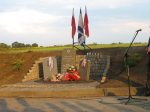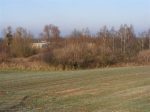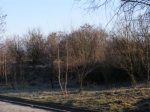| strona główna | cmentarze | warto wiedzieć | księga gości | napisz do nas |
| ALEKSANDRÓW KUJAWSKI | Polish text | ||
"Forever gone from our local reality are Jewish cinnamon shops, |
|||
Jews began to settle in Aleksandrów Kujawski in the seventh decade of the 19th century. They initially fell within the Służew's Jewish community administration, but soon created a kehillah of their own. In the ninth decade of the 19th century a synagogue was erected. Similarily to Aleksandrów and other cities, the Jewish population earned their income through trade -mostly consumer goods, kitchen utensils, tools and textile products and craftsmanship. A proximity to the border meant a portion of Jews were dedicated to trafficking. In the city there were also many shoemaking, hat-making and tailor workshops. The biggest cluster of Jewish homes was located on Długa Street (currently Słowackiego street) and Piłsudskiego Street. In Zbigniew Sołtysinski's, one of the local history aficionados, notes there is a mention from one of the eldest inhabitants of Aleksandrów Kujawski, in which he explains "Jews had their shops on Słowackiego street, in front of the railroad's health center. These were wooden huts which the Germans ordered to be taken down". The turn of the century brought a rapid growth to the local Jewish community. Population rose from 286 inhabitants in 1897 to 977 registering themselves as Jews in the 1921 census. The figure rose to 1011 in 1935. One of every 10 people in Aleksandrów Kujawski was of Jewish faith. The crisis of the interwar era affected Aleksandrów Kujawski's population. Difficult economic conditions, unemployment and a lack of perspective favoured anti-Semitic attitudes. A boycott initiated and fueled by nationalists came as a blow to Jewish businesses. This tense situation created an increase in leftist and Zionist thought amongst Jews. The city had active Jewish social-political organizations such as Brit Hazohar, Hashomer Hacair of the Bund General Jewish Working Uninon . After the outbreak of the Second Word War Aleksandrów Kujawski was annexed to the Third Reich. After the Nazis occupied the city, Jews began to be penalized and assaulted. On September 10th , 1939 the synagogue was set on fire. At the end of 1939 many Jews were forced to leave their family shtetl and head for Warsaw, Grojec, Sokolow Podlaski, Lyszkowice and Belchatow. About 500 Jewish inhabitants remained, who were used by the Germans as slaves in the construction of a road to Ciechocinek, amongst other jobs. After that they were gradually transported to ghettos on the General Government's territories. In 1942 the last group of Aleksandrow Jews were evacuated. They were most likely to be taken to the Chelmno upon Nerem death camp The Jewish cemetery in Aleksandrów Kujawski dates back to possibly the end of the 19th century around the time in which the community became independent. The burial yard was located on the east side of the city, where today's Parkowa street is. During the II World War the Nazis ordered the destruction of the cemetery and had the gravestones used in road constructions. In 2007, Zbigniew Sołtyśiński describes the state of the cemetery in an article published in "The Pulse of Aleksandrów": 'The word Kierchol will be permanently used now to describe the land lots situated on that part of Parkowa street, however nothing but the name remains, as the matzevas were used by the Germans for building roads. I would never imagine that a piece of unkempt land near an embankment , overgrown and surrounded by maple trees, can be a place of eternal rest. With the cordial help of a local I was able to locate the right place, and was furhterly assured that I was not lost by the sight of bones sticking out of the ground". In the 1990s a few meters of the embakment were swept in order to make way for a new lane on the road which now crosses what was once the cemetery. |
|||
 |
 |
 |
 |
Thanks to local efforts, of Zbigniew Sołtysiński and Adam Brzuskiewicz amongst others, and with the help of local authorities led by mayor Andrzej Cieśla, the burial yard of Aleksandrów's Jews finally became commemorated. On September 10th of 2009, 3 granite matzevas situated on the border of the cemetery were unveiled. They read " In memory of Aleksandrów's Jews in the place of the Jewish cemetery. The citizens of Aleksandrów' . Jews with roots in Aleksandrów as well as local authorities, local citizens and representatives from Jewish organizations took part in the ceremony. We recommend a visit to www.sztetl.org.pl where pictures and videos from the ceremony have been uploaded. text: K. Bielawski |
|||
We look forward to receiving any information about Jews from Aleksandrów Kujawski and their cemetery.
We are also awaiting more information from people who remember the cemetery from before World War II. |
|||
 |
|||
The text and pictures are published by the services of www.kirkuty.xip.pl and are the property of the authors. To utilize this material it is necessary to obtain the written permission from the editor. |
|||
| strona główna | cmentarze | warto wiedzieć | księga gości | napisz do nas |
